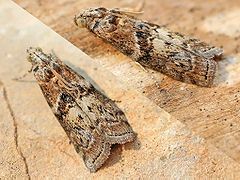Phycitinae
| Phycitinae | |
|---|---|
 |
|
|
Imago of unidentified Acrobasis species (tribe Phycitini) from Tourves (Var, France) Image by entomart.be |
|
| Scientific classification | |
| Kingdom: | Animalia |
| Phylum: | Arthropoda |
| Subphylum: | Hexapoda |
| Class: | Insecta |
| Order: | Lepidoptera |
| Suborder: | Glossata |
| Infraorder: | Heteroneura |
| Division: | Ditrysia |
| (unranked): | Obtectomera |
| Superfamily: | Pyraloidea |
| Family: | Pyralidae |
| Subfamily: |
Phycitinae Zeller, 1839 |
| Type species | |
|
Tinea spissicella Fabricius, [1777] |
|
| Diversity | |
| 4 tribes (and see text) 600 genera 4000 species |
|
| Synonyms | |
|
Anerastiinae Ragonot, 1885 |
|
Anerastiinae Ragonot, 1885
Hypsotropinae Hampson, 1918
Peoriinae Hulst, 1890
The Phycitinae are a subfamily of snout moths (family Pyralidae). Even though the Pyralidae subfamilies are all quite diverse, Phycitinae stand out even by standards of their family: with over 600 genera considered valid and more than 4000 species placed here at present, they unite up more than three-quarters of living snout moth diversity. Together with the closely related Epipaschiinae, they are apparently the most advanced lineage of snout moths.
Phycitinae occur all over Earth's land masses, except in completely inhospitable areas; the majority of species has a tropical distribution however. Phycitinae have even been found on very remote oceanic islands, and a few species have been intentionally or unintentionally distributed by humans beyond their native range.
The type species of this subfamily is Phycita roborella, under its junior synonym Tinea spissicella. That name was apparently first proposed by J.C. Fabricius in his 1776/1777 Genera insectorum but overlooked by subsequent authors, leading to many sources listing its origin as Fabricius' 1790s work Entomologia systematica.
In general, Phycitinae are smallish and slender-bodied moths, resembling fungus moths (family Tineidae) in appearance, though they have the well-developed proboscis typical of snouth moths and in many cases also the tell-tale "snout" consisting of elongated and straight labial palps. They are usually inconspicuous; while the forewings of some are quite prominently patterned, even these have usually rather nondescript greyish-brown colors and in the natural environment the pattern is cryptic. Yet a few species of Phycitinae, such as Oncocera semirubella, are unusually bright-colored by moth standards, while those of genus Myelois resemble members of unrelated "micromoth" family Yponomeutidae and like these are called "ermine moths" due to their bright white forewings with tiny black spots.
...
Wikipedia
